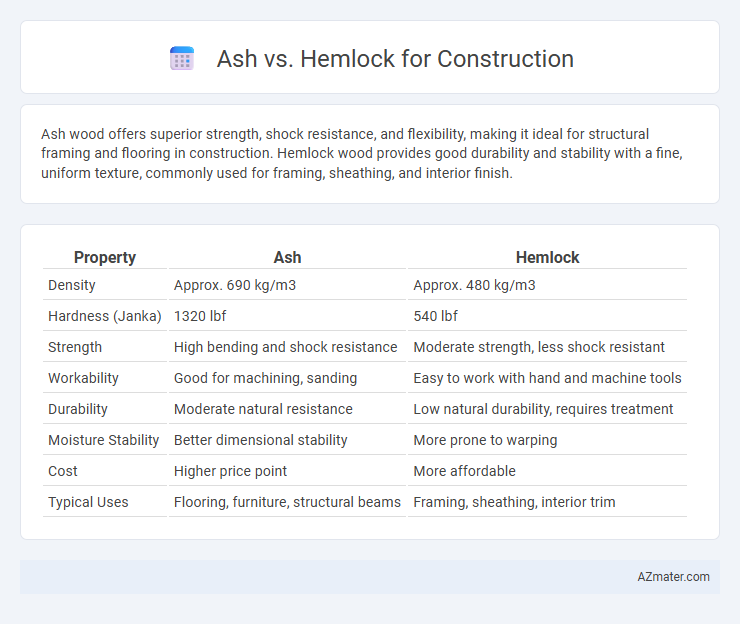Ash wood offers superior strength, shock resistance, and flexibility, making it ideal for structural framing and flooring in construction. Hemlock wood provides good durability and stability with a fine, uniform texture, commonly used for framing, sheathing, and interior finish.
Table of Comparison
| Property | Ash | Hemlock |
|---|---|---|
| Density | Approx. 690 kg/m3 | Approx. 480 kg/m3 |
| Hardness (Janka) | 1320 lbf | 540 lbf |
| Strength | High bending and shock resistance | Moderate strength, less shock resistant |
| Workability | Good for machining, sanding | Easy to work with hand and machine tools |
| Durability | Moderate natural resistance | Low natural durability, requires treatment |
| Moisture Stability | Better dimensional stability | More prone to warping |
| Cost | Higher price point | More affordable |
| Typical Uses | Flooring, furniture, structural beams | Framing, sheathing, interior trim |
Introduction to Ash and Hemlock as Construction Materials
Ash wood is renowned for its exceptional strength, flexibility, and shock resistance, making it ideal for structural components and flooring in construction. Hemlock offers a lightweight yet sturdy option with fine, even grain, commonly used for framing, paneling, and interior finishes. Both woods provide durability and workability, essential for modern building projects demanding reliable and versatile materials.
Botanical and Physical Characteristics
Ash wood, sourced primarily from Fraxinus species, is known for its light color and straight grain, offering high density and excellent shock resistance ideal for structural applications. Hemlock, derived from Tsuga species, features a fine, uniform texture with moderate hardness and good dimensional stability, making it suitable for framing and interior finishes. Both woods provide durability and strength, but ash's superior elasticity and tensile strength often make it preferred for load-bearing elements in construction.
Durability and Lifespan
Ash wood offers remarkable durability for construction projects, with a natural resistance to wear and moderate moisture levels, making it suitable for flooring and framing. Hemlock wood provides a strong structural integrity and good resistance to decay when properly treated, often used in heavy timber framing. Both woods can achieve a long lifespan exceeding 50 years when maintained correctly, with ash favored for its shock resistance and hemlock valued for its dimensional stability.
Strength and Structural Performance
Ash wood exhibits exceptional strength and durability, making it ideal for construction projects requiring high load-bearing capacity and resistance to impact. Hemlock, while less dense than ash, offers commendable structural stability and dimensional consistency, suitable for framing and general carpentry. Combining ash's superior tensile strength with hemlock's workability enhances overall structural performance in building applications.
Workability and Ease of Use
Ash wood is renowned for its exceptional workability, offering a smooth grain that allows for easy cutting, shaping, and fastening, making it ideal for construction projects requiring precision and flexibility. Hemlock, while slightly less dense, provides a lightweight but sturdy option that is easy to machine and fasten, suitable for framing and general carpentry due to its consistent texture. Both woods exhibit good nail-holding capacity and respond well to stains and finishes, enhancing their versatility in various construction applications.
Resistance to Decay and Insects
Ash wood exhibits moderate resistance to decay but is more vulnerable to insect attacks compared to hemlock, making it less ideal for outdoor construction without proper treatment. Hemlock offers superior natural resistance to decay and insects, which enhances its durability in structural applications exposed to moisture and pests. Choosing hemlock for construction projects ensures greater longevity and reduced maintenance costs due to its inherent protective properties against biological deterioration.
Common Applications in Construction
Ash wood's high strength and elasticity make it ideal for flooring, framing, and tool handles, providing durability and shock resistance in construction. Hemlock is commonly used for structural framing, sheathing, and interior paneling due to its straight grain and ease of workability. Both species offer cost-effective solutions for load-bearing elements and finish carpentry, balancing performance with availability in various construction projects.
Sustainability and Environmental Impact
Ash wood offers excellent sustainability benefits in construction due to its rapid growth rates and availability from well-managed forests, ensuring a renewable resource with minimal environmental impact. Hemlock, valued for its strength and decay resistance, is often harvested from sustainably certified forests, reducing habitat disruption and promoting responsible forestry practices. Utilizing Ash and Hemlock in building projects supports carbon sequestration, lowers the carbon footprint compared to steel or concrete, and contributes to more eco-friendly construction methods.
Cost Comparison and Availability
Ash wood offers moderate cost efficiency with prices typically ranging from $3 to $7 per board foot, making it an affordable choice for construction projects. Hemlock tends to be less expensive, averaging around $2 to $5 per board foot, largely due to its abundant availability in North American forests. While Ash is valued for its strength and aesthetic appeal, Hemlock's widespread availability and lower cost make it a practical option for structural framing and general construction needs.
Conclusion: Choosing Between Ash and Hemlock
Choosing between ash and hemlock for construction depends on the specific project requirements, with ash known for its exceptional strength, durability, and shock resistance, making it ideal for flooring and furniture. Hemlock offers a more economical option with good stability and workability, suitable for framing and general structural uses where moisture exposure is limited. Evaluating factors like load-bearing capacity, environmental conditions, and budget ensures the optimal timber selection for long-lasting construction outcomes.

Infographic: Ash vs Hemlock for Construction
 azmater.com
azmater.com